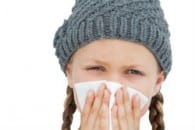Explaining the Common Cold Virus
The common cold is something most people deal with at least once every year but many do not know much about it. The common cold virus is often mistaken for other kinds of viruses and treated with the wrong remedies. Learn more about the common cold virus and be prepared next time it makes its way into your home.
1. Viruses Cause Colds and Coughs
Virtually all colds start off as a common cold virus. Whether or not your child has a fever, green nose, junky cough, or is throwing up mucus, the first several days of any cough and cold is usually due to a cold virus, not a bacteria.
2. Viruses are not Treatable with Antibiotics
Antibiotics will only treat the bacterial complications of colds and cough, such as pneumonia, sinus infection, and ear infection. They won’t help the basic cough and runny nose associated with a common cold virus.
3. It Can Cause Green Nasal Secretions and a Junky Sounding Cough
Decades ago it was commonly felt that a green nose, productive cough, or a rattling chest meant there was a bacterial infection. This belief led to a severe over-use of antibiotics, which in turn has allowed the bacteria that cause ear infections, sinus infections, and pneumonia to become tougher and more resistant to antibiotics. Now we know that green or junky does not necessarily mean a bacterial infection. Viruses can also cause this.
4. Doesn’t a Junky Sounding Cough Mean Bronchitis?
Yes, a junky, productive cough is bronchitis, but no, he may not need antibiotics yet. In children, bronchitis is usually from a common cold virus, not bacteria. The junky cough is usually from mucus dripping down from the nose and settling into the chest. We will discuss later when bronchitis needs an antibiotic.
5. Children Often Vomit Mucus After Coughing Spells
This does not necessarily mean there is something more serious going on. Lots of thick mucus will often trigger vomiting. This is usually just part of a bad cold.
6. The Common Cold Virus can take Two Courses:
- First scenario. Your child starts off with a clear runny nose for a few days, and then she begins coughing slightly. Over the next few days the nose turns from clear, to white, to yellow, then to green. She can’t breathe through her nose. The cough worsens and starts to wake her up at night. About 5 to 7 days into the illness her cough begins to sound junky, you hear some rattling in her chest, and she gets a fever. She may complain of sore throat, headache and stomach ache at this time. The fever lasts for 3 to 5 days yet is seldom higher than 102º. The fever then goes away, but the green nose and junky cough continue. Between 5-7 days the nose starts to seem less thick and green, but the junky cough continues. Over the next week, the nose clears up more, the cough improves slightly, but she still has episodes of junky cough off and on. After about three weeks into the illness the cough quiets down and eventually goes away by four weeks.
- Second scenario. Out of nowhere your child is hit with a high fever, bad cough, headache, sore throat, and runny or stuffy nose. She may have some vomiting or diarrhea, and her sleeping and eating patterns will be poor. The fever, cough, green nose, night waking, and poor appetite continue for 3 to 5 days, then the fever stops. The coughing and green nose continues. Slowly, over a period of 2 weeks the nose begins to clear, the coughing lessens, the appetite returns, and she begins to sleep better at night. After 3 or 4 weeks total, the cough is gone and everything is back to normal.
- While these scenarios sound worse and may last longer than many colds, they are well within the boundaries of what can be expected during the course of the common cold virus. By understanding what should be expected from the common cold virus, you can decide more accurately when to take your child to the doctor, and when to stay home and ride it out. It may be tough to ride it out through the above worst-case cold scenarios. However, if your child is generally acting well when the fever is down, does not have fever lasting more than 5 days (5 complete 24-hour periods), does not have respiratory distress (such as shortness of breath, moderate to severe wheezing, rapid breathing, or chest pains), and overall seems to be okay, then you don’t always need to see a doctor. We will discuss later what signs to watch for that warrant a trip to the doctor.
- Dr. Sears Suggests: When cold symptoms worsen after 5 days or do not improve after 10 days consider your child may have a sinus infection and should be examined by a doctor.
- The main point of these two scenarios is to help parents understand that antibiotics are not necessary for most common colds and coughs. I do recommend you see your doctor if your child has a fever over 103 degrees for 3 or more days. He may not need antibiotics yet for his green nose and junky cough, but your doctor will decide if antibiotics are necessary after examining your child to see if a bacterial infection is present.

